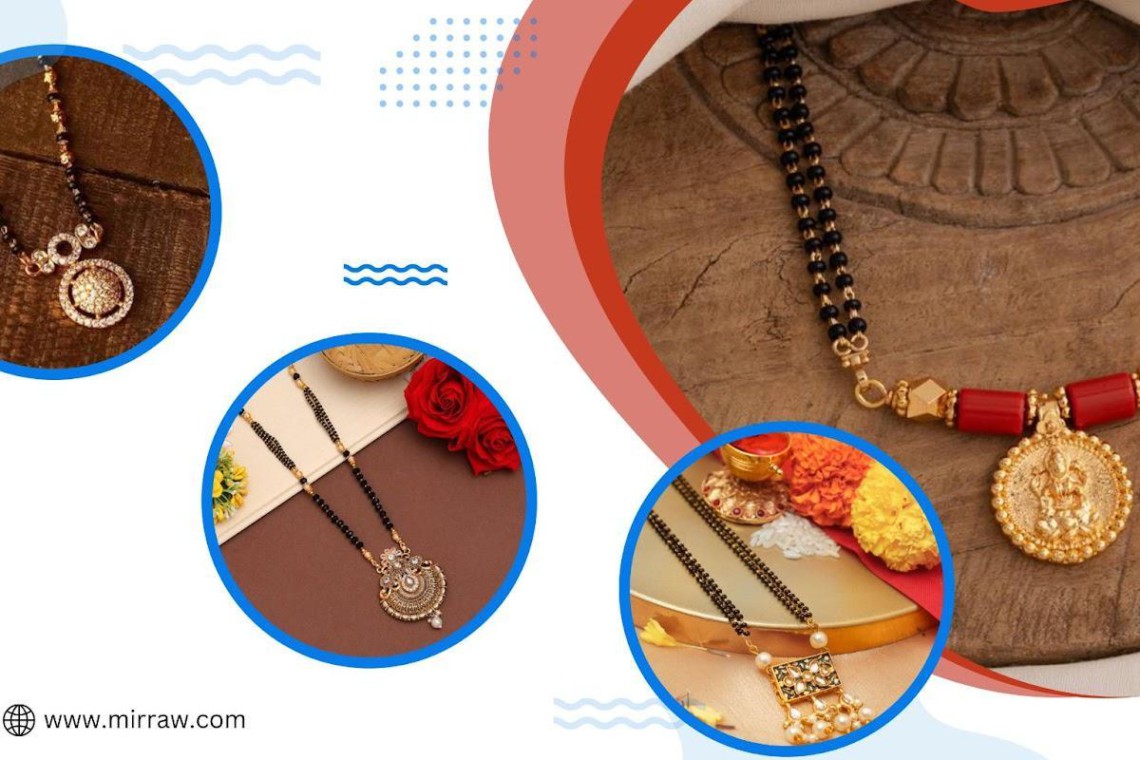Hindu Wedding Dates 2024
- February 23, 2024
- Hindu
Getting married can be one of the most beautiful experiences of one’s life, especially if one is prepping for a… Read More

In almost every culture, there are telling signs of being in a holy matrimony. In the Western world, a ring shows that the woman has a spouse to share the joys and sorrows. In India, the most prominent way of knowing the woman’s marital status is a chain called Mangalsutra. Translating into an ‘auspicious thread’, this chain is tied around the bride’s neck by the groom on the wedding day to bind them together for life.
In earlier times, it used to be a simple thread and therefore translated as the holy thread. As time went on, the traditional mangalsutra was made with gold with black beads inserted in them. This design is significant as the gold signifies Goddess Parvati and the black beads signify her husband Lord Shiva. This couple’s bond is highly revered in the Hindu culture in particular and hence the mangalsutra design is based on their love and devotion to each other. While the gold and black beads are the standards and also the most recognizable elements of the mangalsutra, there are variations in the same based on the Indian state’s traditions and rituals. Let us explore the various designs of the traditional mangalsutra so that you can select the right one.
Mangalsutra Designs In North India
One of the prominent observations in Northern India is that they have tokens such as bangles, toe rings, and nose rings that are considered more important than the mangalsutra. Some of the communities do not wear mangalsutra at all, such as Odiya, Gujarati, and Marwari. While communities such as Bengali and Sikh prefer wearing bangles in red and white color, albeit in different designs and arrangements The above tokens are staples to represent a woman’s marital status. Let us look at some of the traditional mangalsutra designs of some communities.
Starting from the topmost state Kashmir, the mangalsutra worn at their weddings is gorgeous yet steeped in their age-old culture. Instead of a neck chain, the Kashmiri brides wear a set of long chain earrings called Dejhoor. Worn a day before the wedding, the jewelry is at first placed in the piercing of the ear in a red thread. Later, the thread is replaced with a gold chain known as ath that the bride’s in-laws buy. A small gold ornament called Athur or Athoru is also added to the chain. The dejhoor symbolizes a yantra denoting Lord Shiva and Goddess Shakti, the husband-wife duo that Kashmiri Pandits are immensely devoted to. Moving to the other northern state, Bihar, taagpaag is worn by the brides which are long thick mangalsutras with a statement pendant, mostly made with gold and intricate patterns.
In Goa, most Konkanis and Goans wear a traditional mangalsutra named Kasithaali. This is typically a gold chain that has coral and/or gold beads inserted in it. These traditional mangalsutra designs can also have coins that have Goddess Lakshmi’s motif which is the goddess of wealth, Otherwise, the mangalsutra tradition can have a Tanmaniya bead pendant. Meanwhile, in Maharashtra, the traditional mangalsutra consists of a chain of black beads with two bowl-shaped hollow gold discs called vatis. There are two style varieties to choose from – “Nirgun” and “Shagun”. The variation is based on the difference in the arrangement of the black beads.
Mangalsutra Designs In South India
In this part of the nation, the mangalsutra holds quite a lot of importance as compared to its northern counterparts. In each state, the traditional mangalsutra designs are a bit different from each other due to the differences in the culture and rituals. Without further ado, let us get to know the mangalsutra traditional varieties.
In the state of Tamil Nadu, the traditional mangalsutra design is called by various names such as Thirumangalayam, Mangalyam, Thaaly, and Kodi. Some of the important motifs include Goddess Meenakshi (Parvati), Lord Shiva, Tulsi or the deity of the family or clan. During the wedding ceremony, the groom ties a yellow thread or Manja Kayiru around the bride’s neck in three knots with each knot holding a special meaning. Next day, the thread will be replaced by the gold chain.
In Kerala, there are two significant types of mangalsutra designs traditional for two prominent communities that reside in the state. The Hindu managalsutra is called Thaali whereas the Syrian Christian Mangalsutra is called Minnu. Also known as Ela Thaali in the local language, thaali has a leaf-shaped pendant that has the Hindu symbol Om embossed on it. Minnu has a lead-shaped pendant with the symbol of the cross on the pendant. The cross is made of seven gold beads signifying the bride, groom, their parents and the church. The pendant is inserted in the gold chain and this chain is tied by the groom around the bride’s neck.
The Telugu mangalsutra has several names, depending on the culture followed in the part of the state. Some of the names include Bottu, Pustelu, Mangalasutramu, Ramar Thaali and Maangalyamu. The traditional mangalsutra design contains two round-shaped coins or discs. Both bride and groom side will give a disc each on a yellow thread. During the ritual, the groom ties each of these discs with its corresponding yellow thread around the bride’s neck. After sixteen days of the wedding, the yellow thread is replaced with a black and coral beaded chain.
Shop Elegant Traditional Mangalsutra Design From Mirraw
With so many kinds of mangalsutras, you must want to select and shop for the best based on your culture and beliefs. Well, your search for stunning yet traditional styles ends here with the Mirraw online store. From easy-to-apply filters to a smooth delivery process, we ensure you love your online shopping experience with us. From north Indian mangalsutra online to south Indian mangalsutra online, find exquisite varieties here.